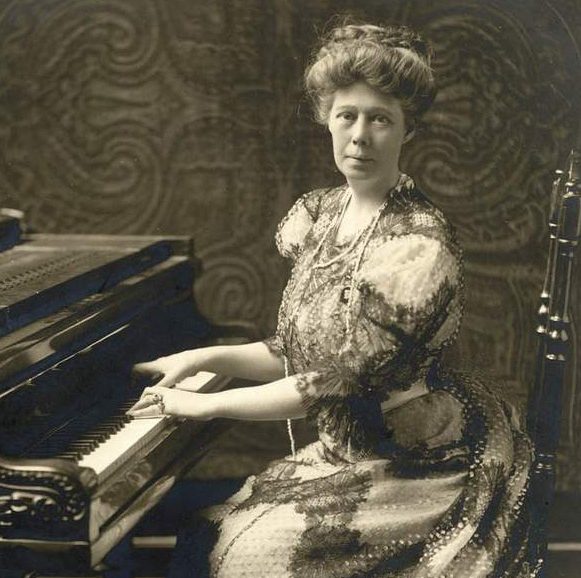‘Without music, life would be a blank to me’, said Jane Austen.
And we could not agree more.
Music can soothe us, energise us, transport us and, above all, inspire us. That is why we are curating this Sheroic Playlist. A list that not only brings you songs, but also introduces you to some extremely inspiring female musicians. Women whose music or lives are sheroic and need to be celebrated.
This fourth round brings you some sheroic classical music composers.
You can listen to it on Youtube.
Enjoy!
 |
Fanny Hensel (née Mendelssohn) 1805-47Fanny was the elder sister of Felix Mendelssohn, the composer. A leading contemporary musician once said of her, “This child is really something special. She plays like a man.”! Unlike most men, however, at 13 she already could play all of Bach’s The Well-Tempered Clavier by heart. Her father and brother encouraged her music making, but only in a domestic environment. In 1829 she married the artist Wilhelm Hensel, who supported her work as a composer. She composed over 460 pieces of music, though some of her songs were originally published under her brother’s name. Thus in 1842 at Buckingham Palace when Queen Victoria told Felix she wished to sing her favourite of his songs, “Italien”, he had to admit that Fanny had written it. In 1970 The Easter Sonata was discovered and attributed to Felix, but finally it was attributed to Fanny in 2010. It was debuted on 8 March, 2017, International Women’s Day. Interest in her music has grown considerably of late, and there are a good number of recordings available.
|
 |
Clara Schumann (née Wieck) 1819-96Clara’s father oversaw her very intensive musical training and her playing was praised by both Liszt and Chopin. At the age of fourteen she wrote her piano concerto, with some help from Robert Schumann, and performed it when she was sixteen at the Leipzig Gewandhaus with Felix Mendelssohn conducting. She was clearly a woman of great personal courage and determination. At 21 she married Robert Schumann against her father’s will. During the May Uprising in Dresden in 1849, she famously walked into the city through the front lines, defying a pack of armed men who confronted her, and rescued her children. It is known that Brahms, 14 years her junior, was passionately in love with her. Clara was primarily a teacher and concert pianist of great renown , but she left an important body of compositions.
|
 |
Hildegard von Bingen 1098-1179Hildegard was a Benedictine abbess, writer, composer, philosopher, Christian mystic, visionary, and polymath. She is considered to be the founder of scientific natural history in Germany. She was elected magistra by her fellow nuns in 1136 and later founded the monasteries of Rupertsberg and Eibingen. One of her works as a composer, the Ordo Virtutum, is an early example of liturgical drama and arguably the oldest surviving morality play. She wrote theological, botanical, and medicinal texts, as well as letters, religious songs and poems. She wrote 69 musical compositions for use in religious rituals, one of the largest repertoires among medieval composers. She has been recognized as a saint by branches of the Roman Catholic Church for centuries. One scholar has asserted that Hildegard made a close association between music and the female body in her musical compositions. And she is also famous for the invention of a constructed language known as Lingua Ignota.
|
 |
Amy Marcy Beach (née Cheney) 1867-1944This American pianist and composer is known for her Gaelic Symphony (1894), the first symphony by an American woman composer. She composed from an early age; when she was four she wrote three waltzes for piano. She was largely self-taught, but was one of the Boston Six school of composers, the youngest and the only woman. Mrs. H.H.A. Beach, as she was known, wrote more than 150 numbered works, nearly all of which were published. They included choral works, church music, chamber works, cantatas, a one-act opera and songs. Her performances and compositions were widely acclaimed in both America and Europe. In 1900, the Boston Symphony premiered Beach’s Piano Concerto, with the composer as soloist. Her music is mainly in the Romantic idiom, and interest in it waned after her death, though it has revived in the past few years.
|
 |
Carrie Jacobs-Bond 1862-1946The American Carrie Jacobs-Bond was the most successful woman composer of her day, earning more than $1 million in royalties from her music before the end of 1910. She began writing music in the late 1880s, encouraged by her husband to “put down on paper some of the songs that were continually running through my mind.” Because her attempts to have her music published were repeatedly turned down by the male-dominated music industry, in 1896 she established her own sheet music publishing company. As a result, she was perhaps the only woman in the industry to own every word of every song she wrote. In 1910 she published “A Perfect Day”, for which 25 million copies of the sheet music were sold. An even more popular song was “I Love You Truly”. In 1941, the General Federation of Women’s Clubs cited Jacobs-Bond for her contributions to the progress of women during the 20th century.
|
 |
Nadia Boulanger 1887-1979 & Lili Boulanger 1893-1918
|
 |
Germaine Tailleferre 1892-1983The sole female member of the post-World War I group of French composers known as Les Six, Germaine Tailleferre left behind, at her death in 1983 at the age of 91, an extensive body of work representing almost 70 years of active composition.
|
‘When I go, I am gonna know that I left something for my people to build on, that is my reward. You got your money, your house, and your easy living, my folks got nothing and they need inspiration 24 hours a day and that is why I am here for’ (Nina Simone)
